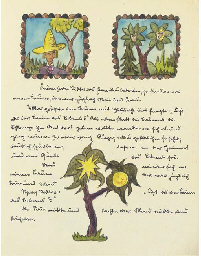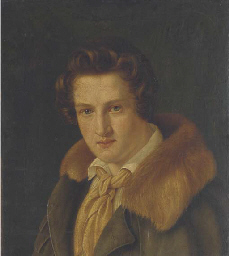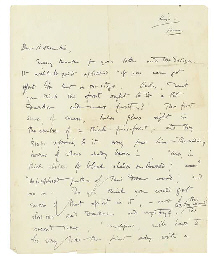TODDINGTON MANOR, GLOUCESTERSHIRE - Charles Hanbury Tracy 1st Lord SUDELEY. A collection of approximately 580 architectural drawings and related images for the construction of Toddington Manor, 1820-1849 and 1862-1876 (many n.d.), the majority in the hand of Sudeley's steward of the Toddington estate, S. Pryce, and initialled by him, but with numerous annotations and additions in Sudeley's hand, also including approximately 18 views of Toddington by R. Kitton, apparently for John Britton's monograph of 1840, and one group of plans, elevations and details for Old Toddington Manor by C. Beazley, Architect, 1806; various sizes, approximately 230 x 100mm - 1620 x 720mm; together with a related group of drawings showing Hampton Court, Herefordshire (10 drawings, also with annotations by the 1st Lord Sudeley), and Gregynog, Montgomeryshire (40). Provenance : 'These drawings are the property of The Lord Sudeley, FSA, to whom they were presented by Mr Peter Stubbs in early 1989. Mr Stubbs had received them "soon after the war" from his tutor in architecture at Cheltenham, Mr Pattinson, who had acquired them from an agent at Toddington at an unknown date. There is every reason to suppose that they constitute the "mass of drawings relating to every stage of its building and ranging from watercolour perspectives to large-scale pencil drawings of details", which Arthur Oswald reported being in Toddington Manor in his article on the subject in the issue of October 9th 1937 of Country Life ' (Michael McCarthy, introduction to his unpublished catalogue of the drawings, 1992, p.2). AN IMPORTANT AND UNPUBLISHED ARCHIVE OF DRAWINGS FOR A VISIONARY BUILDING PROJECT. The drawings comprise designs for all major elements of the house, including the Cloisters, the Private Library and Study, the Breakfast Room and Dining Room, the Library and Drawing Room, the Music Room and Billiard Room, as well as details of chimney pieces, doors, mouldings and other features; a later group of drawings feature designs for the terracing about the parterres. A number of the elevations in particular show plans which differ considerably from those executed, and provide important evidence for the evolution of Sudeley's vision for Toddington. Charles Hanbury-Tracy- ennobled as the 1st Lord Sudeley in 1838, was born Charles Hanbury in 1777; he acquired the name of Tracy, and a considerable estate, through his marriage to Henrietta Susanna Tracy in 1798. Among Henrietta's inheritance was the Gloucestershire estate of Toddington, with its early 17th-century house, to which the couple moved. The old house formed three sides of a courtyard, with the fourth comprising a wall and gateway. When one wing burnt down in 1803, the architect Charles Beazley was engaged to rebuild it (Beazley's drawings are preserved in the present collection), but by 1815 the appearance of dry rot in the new wing, and the increasingly delapidated condition of the house as a whole, persuaded Hanbury-Tracy to embark on the construction of an entirely new house. This, he decided, in the teeth of the prevailing neo-classical vogue, was to be built in the Gothic style: 'I will venture to say that [Gothic] is better adapted to the climate of domestic architecture than Grecian, the beauty of which depends on porticoes etc. too well calculated to exclude what little sun we are favoured with'. Christopher Hussey comments that 'whereas Fonthill or Belvoir were fanciful extravaganzas on an ancient castellated or monastic theme, at Toddington a serious attempt was made to combine a rational plan (by the standards of the 19th Century) with the architectural style most widely admired at the time' ( English Country Houses: Late Georgian 1800-1840 , London, 1958). In this revolutionary fully thought-through Gothic style, Toddington was perhaps two decades earlier than any comparable endeavour. More remarkable still, Hanbury-Tracy elected to design the house, and oversee the works, himself, without the aid of a p
TODDINGTON MANOR, GLOUCESTERSHIRE - Charles Hanbury Tracy 1st Lord SUDELEY. A collection of approximately 580 architectural drawings and related images for the construction of Toddington Manor, 1820-1849 and 1862-1876 (many n.d.), the majority in the hand of Sudeley's steward of the Toddington estate, S. Pryce, and initialled by him, but with numerous annotations and additions in Sudeley's hand, also including approximately 18 views of Toddington by R. Kitton, apparently for John Britton's monograph of 1840, and one group of plans, elevations and details for Old Toddington Manor by C. Beazley, Architect, 1806; various sizes, approximately 230 x 100mm - 1620 x 720mm; together with a related group of drawings showing Hampton Court, Herefordshire (10 drawings, also with annotations by the 1st Lord Sudeley), and Gregynog, Montgomeryshire (40). Provenance : 'These drawings are the property of The Lord Sudeley, FSA, to whom they were presented by Mr Peter Stubbs in early 1989. Mr Stubbs had received them "soon after the war" from his tutor in architecture at Cheltenham, Mr Pattinson, who had acquired them from an agent at Toddington at an unknown date. There is every reason to suppose that they constitute the "mass of drawings relating to every stage of its building and ranging from watercolour perspectives to large-scale pencil drawings of details", which Arthur Oswald reported being in Toddington Manor in his article on the subject in the issue of October 9th 1937 of Country Life ' (Michael McCarthy, introduction to his unpublished catalogue of the drawings, 1992, p.2). AN IMPORTANT AND UNPUBLISHED ARCHIVE OF DRAWINGS FOR A VISIONARY BUILDING PROJECT. The drawings comprise designs for all major elements of the house, including the Cloisters, the Private Library and Study, the Breakfast Room and Dining Room, the Library and Drawing Room, the Music Room and Billiard Room, as well as details of chimney pieces, doors, mouldings and other features; a later group of drawings feature designs for the terracing about the parterres. A number of the elevations in particular show plans which differ considerably from those executed, and provide important evidence for the evolution of Sudeley's vision for Toddington. Charles Hanbury-Tracy- ennobled as the 1st Lord Sudeley in 1838, was born Charles Hanbury in 1777; he acquired the name of Tracy, and a considerable estate, through his marriage to Henrietta Susanna Tracy in 1798. Among Henrietta's inheritance was the Gloucestershire estate of Toddington, with its early 17th-century house, to which the couple moved. The old house formed three sides of a courtyard, with the fourth comprising a wall and gateway. When one wing burnt down in 1803, the architect Charles Beazley was engaged to rebuild it (Beazley's drawings are preserved in the present collection), but by 1815 the appearance of dry rot in the new wing, and the increasingly delapidated condition of the house as a whole, persuaded Hanbury-Tracy to embark on the construction of an entirely new house. This, he decided, in the teeth of the prevailing neo-classical vogue, was to be built in the Gothic style: 'I will venture to say that [Gothic] is better adapted to the climate of domestic architecture than Grecian, the beauty of which depends on porticoes etc. too well calculated to exclude what little sun we are favoured with'. Christopher Hussey comments that 'whereas Fonthill or Belvoir were fanciful extravaganzas on an ancient castellated or monastic theme, at Toddington a serious attempt was made to combine a rational plan (by the standards of the 19th Century) with the architectural style most widely admired at the time' ( English Country Houses: Late Georgian 1800-1840 , London, 1958). In this revolutionary fully thought-through Gothic style, Toddington was perhaps two decades earlier than any comparable endeavour. More remarkable still, Hanbury-Tracy elected to design the house, and oversee the works, himself, without the aid of a p















Try LotSearch and its premium features for 7 days - without any costs!
Be notified automatically about new items in upcoming auctions.
Create an alert